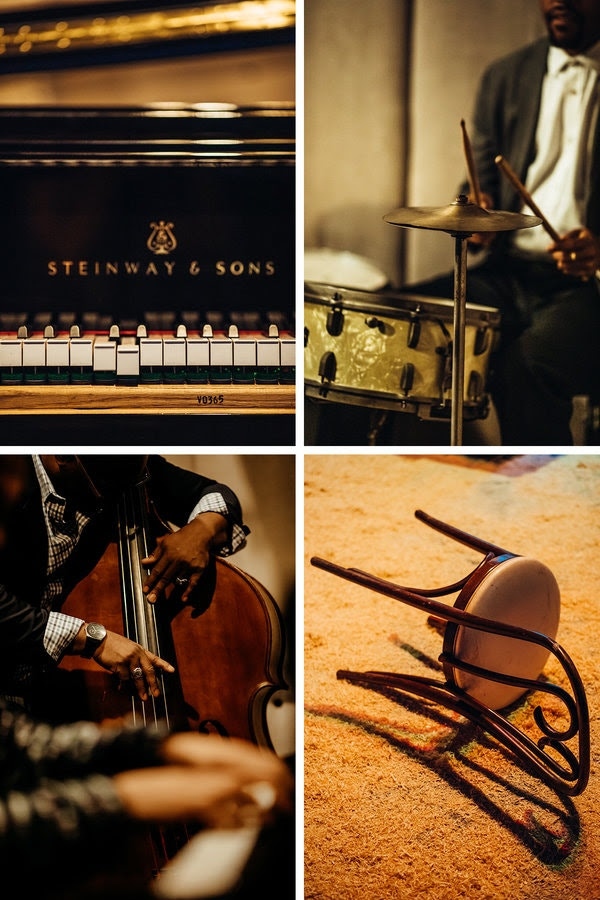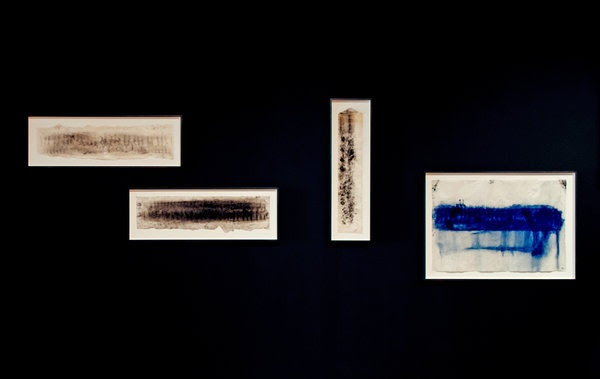Jason Moran’s Jazz Journey at the Whitney Upends Space and Time
By Giovanni Russonello
Updated Sept. 27, 2019, 12:19 a.m. ET
The pianist and conceptual artist engages with the physical history of jazz in collaborations with Kara Walker, Joan Jonas and other art world figures.

Jason Moran performing with his trio, the Bandwagon, at the Whitney Museum of American Art. Performance is as much a part of his exhibition as his sculptures and drawings.Sasha Arutyunova for The New York Times
At the Whitney Museum of American Art last week, Jason Moran and his Bandwagon trio had been playing for about 10 minutes inside a replica of the stage at the Three Deuces, a bebop club from 1940s New York, when he suddenly got up from the piano and snaked through the crowd assembled inside the museum’s eighth-floor gallery.
While the drummer Nasheet Waits soloed back at the Three Deuces, Mr. Moran and the bassist Tarus Mateen strode onto a different set, this one recreating the downtown ’60s haunt Slugs’ Saloon. Mr. Waits joined them there and the trio got moving again, from jagged-edged 21st-century blues to reworkings of Thelonious Monk.
In the rollick and riot of the group’s performance, and the curious engagement of the riled-up crowd, these two stages came to life, just as the original clubs once had.
Sign up for the Louder Newsletter
Stay on top of the latest in pop and jazz with reviews, interviews, podcasts and more from The New York Times music critics.
The performance christened a new exhibition, “Jason Moran,” the first museum survey devoted to this MacArthur-winning pianist and conceptualist. (The show opened last year at the Walker Art Center in Minneapolis, and traveled to two other cities before arriving at the Whitney. It will be up through Jan. 5.) It is an undeniable — if unsurprising — milestone in the career of an artist who has always insisted on moving laterally between artistic practices, and up the art world’s ladder.

Three replicas of stages, including the one at Slugs’ Saloon, above, dominate the exhibition’s main gallery. Large screens show videos and stills from Mr. Moran’s collaborations.Sasha Arutyunova for The New York Times
The Whitney show comprises works made with leading art world figures like Julie Mehretu, Carrie Mae Weems, Stan Douglas, Kara Walker and Glenn Ligon. “I was wondering: ‘Why are all these incredible artists linked to this one person?’” Adrienne Edwards, curator of performance at the Whitney and the exhibition’s chief creative architect, said in an interview. “He’s the common denominator, so I became interested in why.”
Mr. Moran and Ms. Edwards intend the exhibition as not just a welcoming of Mr. Moran’s creative conclave, but also as its own, living space. “It’s a solo show — ‘Jason Moran’ — but it’s also a group show,” Ms. Edwards said. “It was about how to keep all these things in the air and floating, as equal parts, in an exhibition format.”
Typically seeing a museum show might involve walking through a number of galleries, but in this one your relationship to space and time is turned sideways. The exhibition’s physical contents are mostly centered in one large room, yet because so many are music- and video-based, you spend a lot of time stationary, letting things play out, as if you were at a performance. And there will indeed be more performances. The stages here will be reactivated most weekends this fall by concerts from jazz groups selected by Mr. Moran. On Oct. 12, he will perform outside the museum on a giant, earsplitting calliope built by the visual artist Kara Walker, meant to evoke the horrors of slavery in the South, and on which Mr. Moran will play songs from the African-American canon.
The main gallery is dominated by the stage sculptures — three in all — which Mr. Moran created with help from fabricators. They are large-scale dioramas of the rooms that once existed at Slugs’ Saloon in the East Village, the Three Deuces in Midtown and the Savoy Ballroom in Harlem. On the gallery’s navy-gray walls, three large screens show videos and stills from Mr. Moran’s collaborations. The visuals run without repeating for over two hours, and include footage of him working with Joan Jonas, Theaster Gates and others; video pieces he made with Ms. Walker, Ms. Weems and Lorna Simpson; and photos from his collaborations with others, accompanied by Mr. Moran’s piano playing, which wafts up spectrally from the Three Deuces’ baby grand (it has player-piano capabilities, so the keys are actually playing themselves).

A large-scale diorama reimagines a room at the Savoy Ballroom in Harlem.Sasha Arutyunova for The New York Times

Details from the exhibition (and a recent concert), which will feature weekly performances.Sasha Arutyunova for The New York Times
A small side theater shows Mr. Douglas’s six-hour-long music video, “Luanda Kinshasa,” a period-specific rendering of a 1970s recording session (suggesting a conversation with the intense nostalgia of Mr. Moran’s stages).
The foyer outside the gallery is lined with 10 works on paper, which Mr. Moran made by covering his keyboard with sheets, dipping his fingers in charcoal, and playing. The drawings operate as a kind of kinetic residue of performance, or an alternate notation system. (They have equal roots in the history of nonstandard musical notation, dating back at least to the jazz avant-garde of the 1960s, and in David Hammons’s basketball drawings.)
From his adolescent years, Mr. Moran felt a resonance between music and other forms of art. But as a student at Manhattan School of Music, he found that jazz’s history was largely passed down in the form of exercises and sheet music.
To escape those limitations he sought out painters and other artists, placing them at the center of his process in the way that early jazz musicians had dancers. “I had to see what somebody else thought about the music — not a jazz musician,” he said over coffee recently, in a restaurant near the Whitney.
But it wasn’t until he worked with Ms. Jonas, an art-world eminence, in the mid-2000s that he began to see himself as a conceptual artist. Ms. Jonas makes performance art that leans into questions of physical space and the limits of archival media. Mr. Moran was inspired to bring some of her methods into his own practice.
And Mr. Moran’s influence flowed back to her as well. In their performance she felt inspired to participate in the music-making process for the first time. “Jason, in a way, allowed me to become a musician, to become a percussionist,” Ms. Jonas said in a phone interview. “He’s a very generous collaborator.”
And thanks to her, Mr. Moran saw that a conceptual approach could lead him into an encounter with jazz’s physical history: the spaces and bodies that made its greatest moments possible. This, in effect, could become a way of celebrating the entire culture that the music sprang from — but which often finds itself erased in history, especially as the music rises into the academy.

Works by Jason Moran, from left, “Run 2” (2016), “Run 6” (2016), “Strutter’s Ball” (2016) and “Blue (Creed) Gravity 1” (2018). The first three are works of charcoal on paper; the last piece is made from dry pigment on paper.Sasha Arutyunova for The New York Times
“When I think about all that has happened in those clubs, in those venues, with those audiences, with all the ephemera that is left behind — that tells a fuller picture of what the music is,” Mr. Moran said, pondering his stage sculptures. “That’s without the sound.” At the show, each stage replica is juxtaposed with a small display of photographs, souvenir cards and other objects from the old clubs themselves. Mr. Moran acquired these items, mostly on eBay.
The big precursor to “Jason Moran” was “Bleed,” the weeklong residency that Mr. Moran and the operatic vocalist Alicia Hall Moran — his wife, and his first and most consistent collaborator — presented at the 2012 Whitney Biennial. Just like their recent stage production, “Two Wings: The Music of Black America in Migration,” which debuted this year at Carnegie Hall, “Bleed” too was a convocation of friends and collaborators, its form dictated by their intersections.
It worked as a subtle suggestion that the Whitney might someday become a rich home for performances. And it showed that as black visual artists steadily rise in the contemporary pantheon, more room will have to be made for their counterparts in music and performance, since the art of the African diaspora has always been, by its very essence, interdisciplinary.
The museum has presented jazz and classical concerts since the 1960s, but it has never championed performance on the same level as visual art. Picking up on what “Bleed” put down, thinking and working together, Mr. Moran and Ms. Edwards have made that seem possible.
Jason Moran
Through Jan. 5 at the Whitney Museum of American Art, 99 Gansevoort Street, Manhattan; 212-570-3600, whitney.org.
Performance highlights include the saxophonist Archie Shepp on Sept. 25-26; the vocalist Fay Victor on Oct. 18-19; the Onyx Collective on Nov. 1-2; the bassist Cecil McBee on Nov. 15-16; and the Tiger Trio on Jan. 3-4. Kara Walker’s “Katastwóf Karavan” calliope will be on display outside the museum on Oct. 12, and Mr. Moran will perform on the calliope at 6 p.m.
A Closer Look at ‘Katastwóf Karavan’
You've been a subscriber for over 7 years.
Now share a year of The Times with someone.
Subscribers can purchase gifts at a 50% discount.
Tune up your Times experience.
Tune up your Times experience.
|